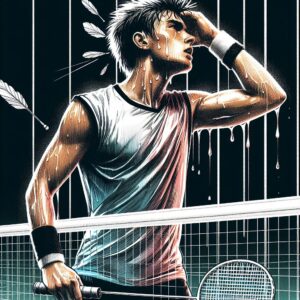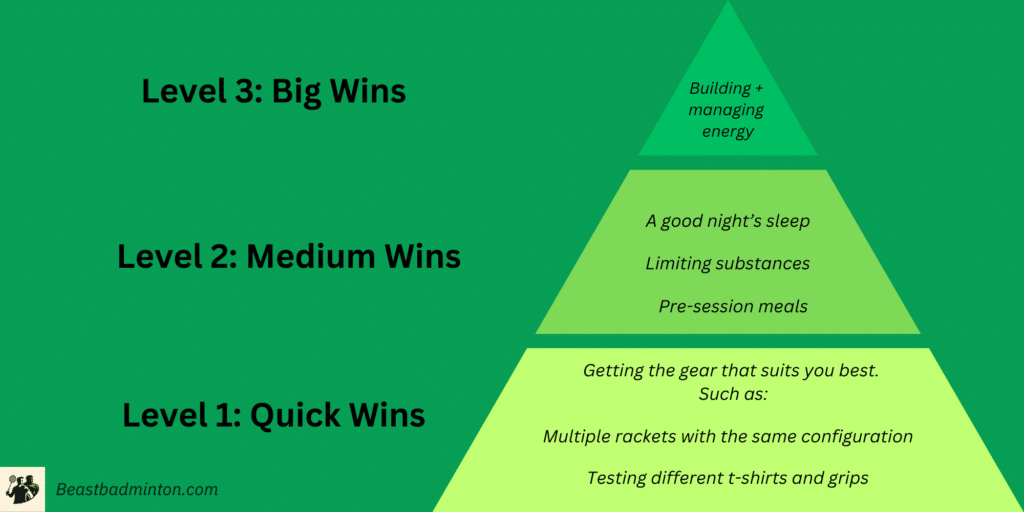Sweating is one of the most incredible developments that distinguish us from animals. It allows us to recover while moving whereas most animals have to stop to catch up.
Imagine how difficult it would be to play badminton if we had to pause mid-rally to catch our breath all the time.
On the court, sweating is awfully distracting though. I can’t count the number of times I’ve been struggling to switch grip fast enough for my sweaty palms to keep up in a drive duel or defense situation.
Since it’s like a sauna where I play, I’ve been experimenting with different ways to manage sweat to limit how much it impacts my game. It’s impossible to get rid of entirely, but there are certainly things we can do to manage it so it has less of an effect.
In this article, I’ll walk you through what I’ve learned. We’ll dive into ideas ranging from affordable gear you can buy to major changes that require energy if you’re serious about making changes.
I’ll classify myself as a “midrange sweater”: I don’t sweat excessively, but still enough that it affects my game here and there, so take this with a grain of salt if you find yourself in a different category.
Table of Contents
Badminton and sweat: the four ways it affects your game
Let’s begin by looking at which areas of the game sweat causes the most trouble on court.

Slipping on court
The scariest result of sweating is slipping on court. I’m sure you’ve also experienced walking on court, noticing pools of sweat you have to clean up to avoid a slippery surprise mid-rally, even if you’re wearing the best badminton shoe grip out there.
At its worst, you’ll get injured right then and there. But even if you don’t, a tiny slide can be enough for us to lose confidence moving around the court. I bet that if you’ve dodged a bullet, the thought of slipping again is lingering in your mind for the rest of the session and it’s hard not to hold back just slightly instead of giving it your all.
Heck, you might even slide inside your shoe which is frustrating enough on its own, but at least it’s fairly easy to control that with the right pair of insoles or shoes.
Changing grips
Changing grips during fast exchanges like midcourt drive duels or defense is hell if your sweaty palms aren’t able to grip your racket properly. At times, I’ve even felt it necessary to play more defensive shots, like lifting, to avoid hitting the net as I was struggling to grip my racket with confidence quickly enough with a slippery handle.
A dangerous choice if you’re serious about winning.
But it’s not just in defense you might get in trouble. Another player I spoke to shared how the wrong grip kills their confidence in overhead strokes like smashing as they feel that the racket is going to slip out of their hands.
These subtle examples suggest that it’s time to change your grip or even experiment with towel grips if you haven’t already.
Blisters on your feet
When you’ve decided to hand over your hard-earned cash for a top-of-the-line badminton shoe, one of the most frustrating things is getting blisters or fatigue because it doesn’t fit your feet well.
Sizing is one thing, but the fit in the toe box or heel can make it painfully distracting and difficult to play with focus. I’ve experienced that firsthand with most of Yonex’s top-range badminton shoes.
For a long time, I assumed that most players also got toe fatigue on the side of the big toe, and that’s just how it was supposed to be (it’s not!)
Sweat is a great addition if you’re attempting to turn that fatigue into blisters. During my shoe tests, I’ve noticed how lightweight shoes seem to have more difficulty absorbing or transporting the sweat away and instead feel wetter within the shoe. Counterintuitive, I know.
The psychological effect
Each situation is one thing while it happens, but the real distraction is the subtle anxiety we get wondering when it’ll happen again.
I’m sure you’ve also been in a situation where you moved slightly less to avoid slipping instead of going for that difficult retrieval, or playing a passive shot instead of attacking, all while attempting not to get distracted by foot fatigue.
It’s not exactly the most joyful badminton experience.
Next, let’s explore how we can better manage sweating while playing badminton.
The pyramid of sweat management in badminton
In this pyramid of sweat management, I’ll start out looking at things you can easily fix by spending a few bucks on gear before gradually moving on to more difficult items. These require more effort and a longer time to achieve as opposed to just spending money.

Let’s dive right into the first stage.
Level 1 – quick wins
Let’s start by addressing sweaty palms.
Sweaty palms, face, and arms
The most affordable place to start is by experimenting with different handle grips. If you haven’t tried towel grips yet, that’s a great place to start as they are intended for this purpose, and if that isn’t enough, grip powder can help even more.
If you’re not a fan of towel grips and prefer PU overgrips as used to be the case for me, I’ve found that there can be quite a difference between grips even within the category.
To take it a step further, I’ve found it useful to get an extra of your preferred racket with the same configuration (strings and handle), so they are identical. That allows you to switch between rackets for each game, so one can dry off slightly before getting back in action.
Many players seem to like having two different rackets to switch between. In my experience, you’re worse off as you’ll have to adjust your technique all the time. If you end up with different shuttles every now and then, this gets even worse as there are several things to adjust to.
Moving on from your palms, sweat running down your arms can also make your palms and racket more sweaty. This is where wristbands come in as they can help remove some of it before reaching your palm in the first place.
I found that the extra heat they produce wasn’t worth the trade-off for me, but it depends on how much you sweat and how distracting it is for your game.
Along the same lines, headbands can reduce the sweat from your forehead and eyes while keeping your hair from irritating your face. They make a big difference in reducing sweat while I’m playing.
Towels and t-shirts
I figure most players are aware of the benefits of bringing a towel to dry off the sweat from your palms and face, but in case you aren’t, this makes a huge difference. Even if you already bring one, have you experimented with which size is best for you?
This sounds like nothing, but if your entire towel is soaked halfway through your session, what good is it for the remaining part when you need it the most?
Not to mention that there’s a meaningful difference in quality and how much sweat different material can soak up.
Apparel can make a difference too.
If you find it impossible to dry off your palms in your shirt or shorts between rallies because they’re as wet as a bathing suit in the pool, that isn’t helpful. Bringing both multiple t-shirts and shorts to switch during your session can help as well.
I’ve found cotton T-shirts to feel heavier and get much wetter than sports t-shirts made from polyester material. But even within t-shirts made from 100% polyester, there’s a huge difference in how they handle sweat: some feel soaked whereas others only feel slightly wet in comparison.
Finally, let’s move on to your feet.
Your feet
If you’re having issues with blisters and feel like your shoes are the right size and fit, consider experimenting with thicker or thinner socks and sports tape in the exposed area. It might help you sweat less or protect your feet more.
It’s possible to solve this by trying different insoles in your badminton shoes, especially if you feel like you’re sliding around within the shoe as was the experience for me when testing the Yonex Aerus Z2 and Mizuno Wave Claw 3.
With these easy wins out of the way, let’s move on to the second stage.
Level 2 – medium wins
The next stage is a major step up in difficulty for some and a breeze for others depending on your relationship with these items.
Pre-game preparation
The big one is what you do leading up to the game. Some keep it clean while others go on a binge the night before.
I usually play before noon, so getting a good night’s sleep and limiting alcohol and other substances make a meaningful difference to how much I sweat on court. In fact, it might just be the things that have been the easiest for me to notice making a difference.
Within this is also what we eat leading up to the game, and if you eat at all. I’ve found that I recover better if I’ve eaten something simple before playing, even if it doesn’t directly impact sweating.
Level 3 – big wins
At the final stage are the items I’ve found to make the biggest impact, but that also requires the most effort, especially as it compounds over time.
Getting more energy
As a recreational player, I’ve found the single biggest change to mitigate sweat affecting your performance on court is improving your stamina and agility.
Yes, there are exceptions as some players are in great shape and will see fewer benefits from improving their stamina. I consider myself somewhere in the middle, and I’ve seen great improvements from working on this off-court.
Recovering quicker between rallies and games has resulted in me sweating noticeably less while playing. That led to going through fewer t-shirts per session with less sweaty palms.
Biking regularly has been a simple and useful exercise, but I’ve discussed different options in articles on training.
Managing your energy
Being more energy efficient means using your existing energy in a smarter way.
One smarter way is paying more attention to how you move on court. By improving your footwork, you’ll move more efficiently around the court.
It’s especially effective when combined with better anticipation of what your opponent is about to do. You’ll often see senior players kick younger players’ ass because reading their minds better.
Another option is using your backhand more instead of moving around the court that bit extra to position yourself for an aggressive overhead shot. You’ll save some energy (and thus sweat slightly less), but the trade-off is that you might get in trouble on the following shots. Particularly, if your opponent notices this and changes their tactics to take advantage of it.
What makes these skills hard is the amount of practice it takes to see real results and how little deviation will mess it up. If you’ve ever tried working out regularly but taken a break while on holiday, you know what it’s like.
Before you know it, it’s been months since you exercised off-court, and the stamina built up is gone.
What are your best tips to avoid sweating or mitigate it on court?
Leave a comment below.